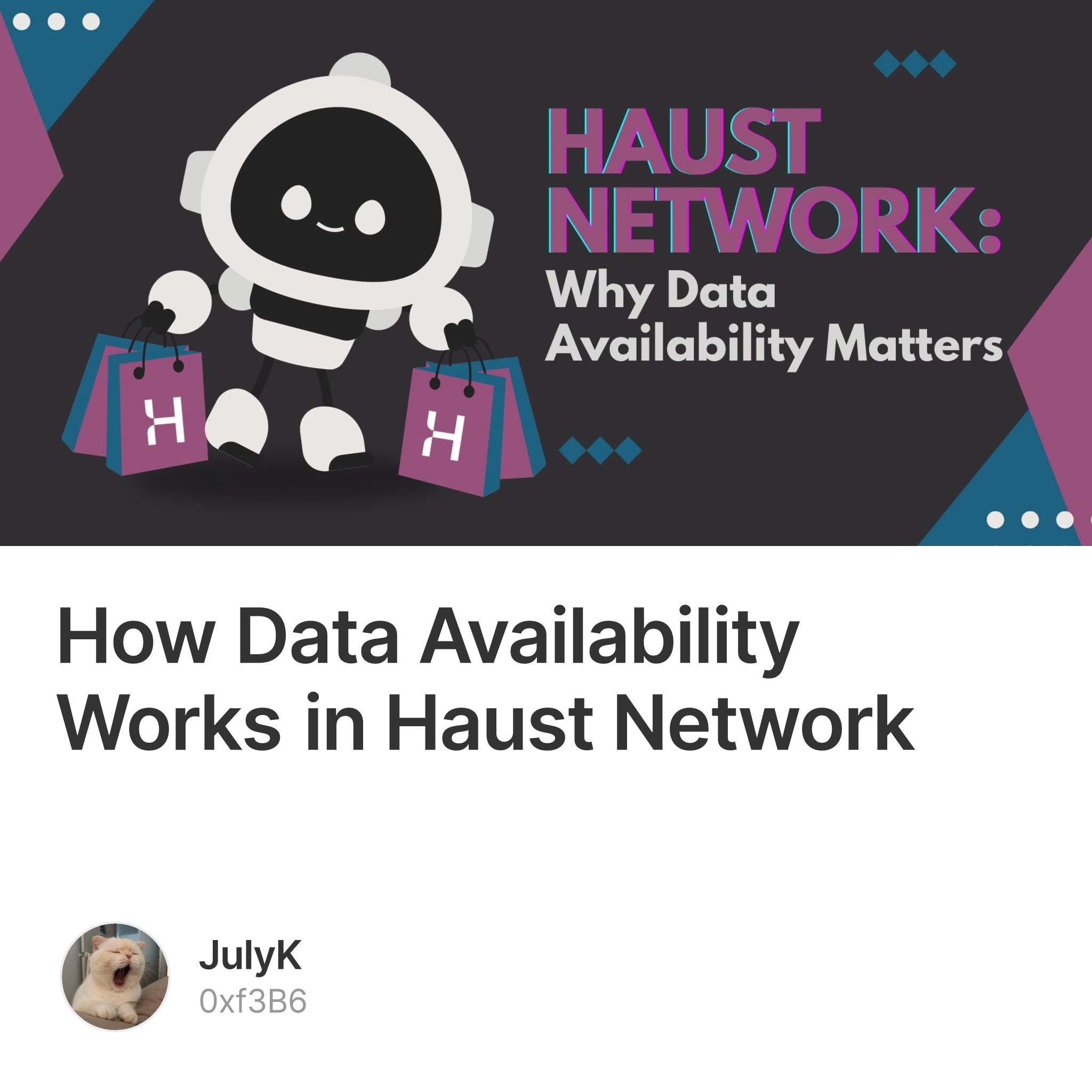In blockchain architecture, the reliability and accessibility of transaction data are essential. As decentralized systems evolve and take on greater responsibilities, ensuring that critical data is consistently available becomes a primary requirement. In Haust Network, Data Availability is a one of the key technical component that supports network efficiency, security, and scalability.
Understanding Data Availability

Data Availability refers to the system's ability to ensure that all data related to transactions is continuously accessible and can be independently verified. This is particularly relevant for Layer 2 protocols, where large amounts of data are handled off-chain in order to reduce on-chain congestion and improve throughput.
Even though transaction data may not be directly stored on the main blockchain, the network must make sure that this data remains provable and retrievable. Any validator, auditor, or user should be able to verify the correctness of a transaction or state transition based on the available data. If this guarantee is not maintained, the network risks losing transparency and weakening its security model.
NEAR DA in Haust Network

Haust Network utilizes the NEAR Data Availability Layer to manage transaction data outside of the execution layer. This architecture allows Haust to scale more efficiently by separating the concerns of computation and data storage. Rather than processing and storing everything in a single layer, transaction data is sent to a dedicated availability layer optimized for performance and redundancy.
The NEAR DA system distributes data across multiple independent nodes using a technique known as sharding. This ensures that no single point of failure can compromise data availability. Additionally, erasure coding and cryptographic methods are applied to enhance data resilience. These mechanisms make it possible to recover the original data even in the event of partial node failure or network interruption.
This structure gives Haust the ability to maintain high transaction throughput without overloading the network with unnecessary data replication, while still ensuring that the data remains verifiable at all times.
Security Implications

One of the most important roles of the Data Availability Layer is to strengthen network security. When transaction data is stored off-chain, the system must have strong guarantees that this data has not been lost, withheld, or altered. Haust addresses this by ensuring that all off-chain data submitted to NEAR DA is backed by cryptographic proofs.
The use of authenticated data structures and verifiable commitments means that even if users do not store the full transaction history themselves, they can verify its integrity at any moment. This promotes transparency and helps detect any inconsistencies in how transaction data is handled.
Furthermore, the availability of data enables independent observers to challenge invalid state transitions or fraudulent transactions. If a malicious actor attempts to manipulate the system, validators and auditors can refer to the available data to detect the issue and enforce corrective measures. This capability is critical for maintaining long-term trust in the network.
Operational Efficiency

Data Availability also plays a major role in improving the operational efficiency of Haust Network. By relocating data to a dedicated availability layer, the main execution environment can function without being slowed down by large volumes of storage and retrieval operations. This division allows transaction processing to remain consistent even during periods of high network demand.
The result is faster confirmation times, better network responsiveness, and more consistent performance for decentralized applications built on Haust. Developers can build complex protocols without being limited by on-chain data constraints, and users benefit from lower transaction costs and smoother experiences.
Benefits for Users

Data Availability’s impact is directly felt by users. Some of the main user-facing advantages include:
-
Improved Network Stability: The system remains functional and efficient even during peak usage times.
-
Transparent Infrastructure: Anyone can validate data authenticity independently, which increases confidence in the system.
-
Cost Optimization: The separation of data availability from execution reduces fees for transactions and operations.
-
Assured Data Integrity: Users know that their transaction history is preserved and can be verified if needed.
These advantages make Haust an appealing platform for everyday users, developers, and financial protocols that require reliable performance and transparency.
Conclusion

Haust Network places Data Availability at the core of its architecture to support scalability, security, and reliability. By offloading data storage to a specialized layer and ensuring verifiable access through cryptographic methods, Haust creates an infrastructure that meets the needs of modern decentralized applications. For users, this results in faster, more affordable transactions. For developers, it unlocks the ability to build scalable products without worrying about data consistency. And for the network as a whole, it provides a foundation that is resilient, efficient, and future-ready.
As blockchain adoption grows, the systems that can handle data securely and reliably at scale will define the next era of decentralized innovation. Haust Network is prepared for that future.
More information about the project can be found below:
Twitter: https://x.com/HaustNetwork
Discord: https://discord.com/invite/QWGxjTXD8N
Web-site: https://haust.network/
Telegram: https://t.me/haustnetwork

